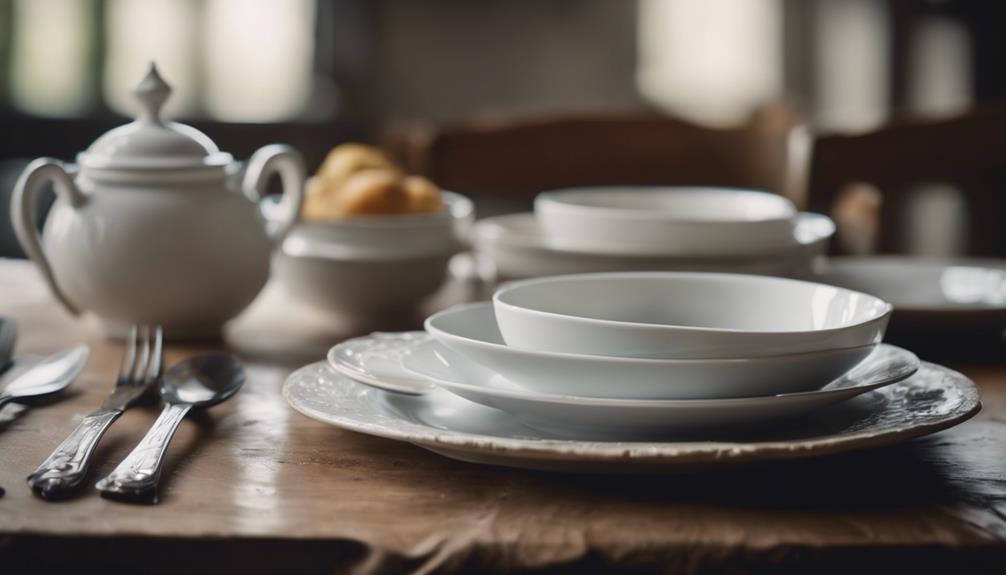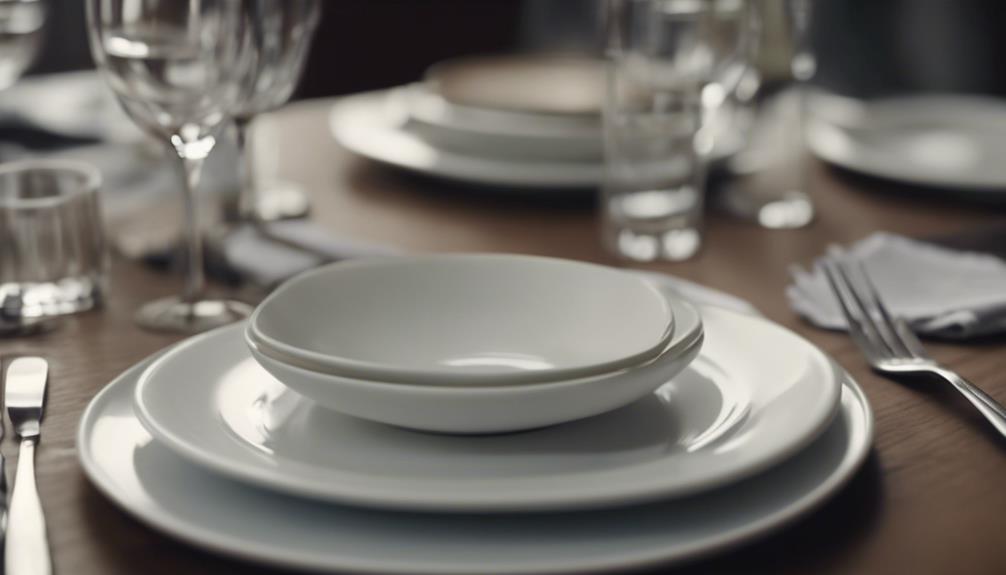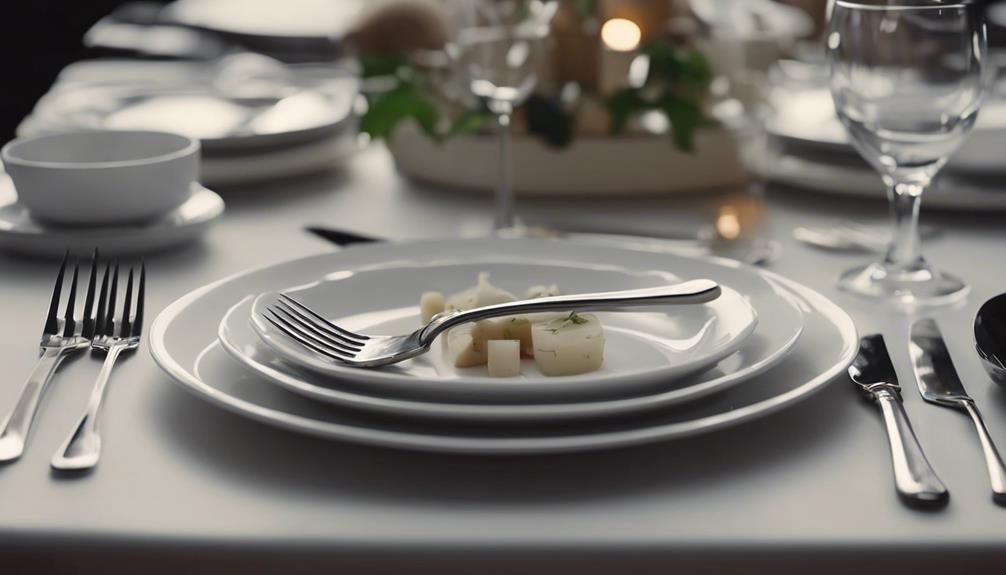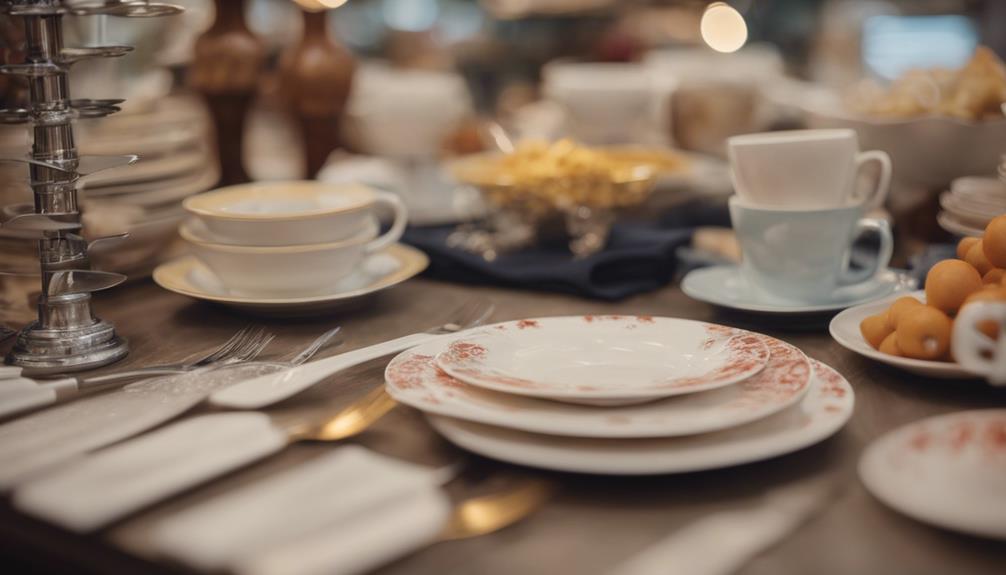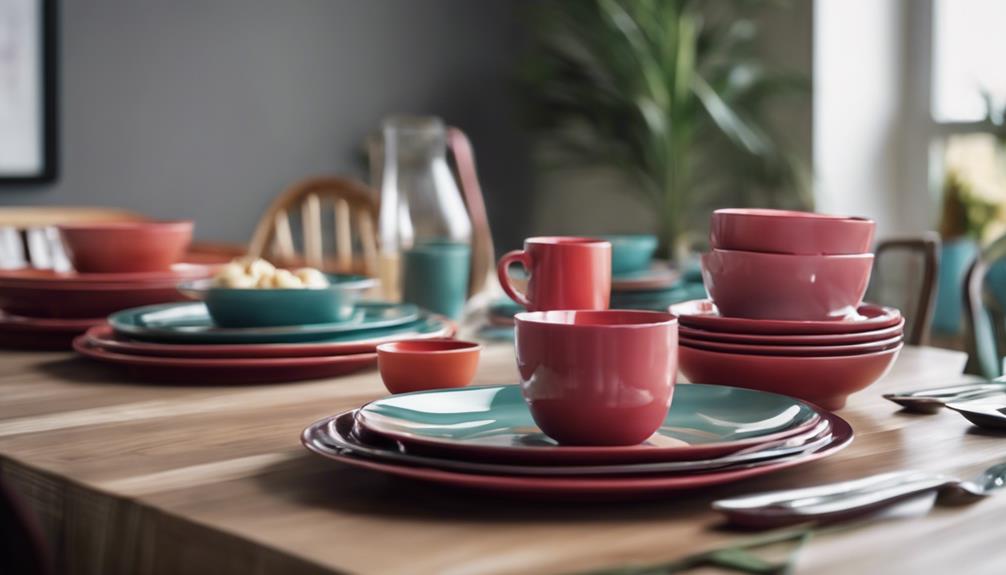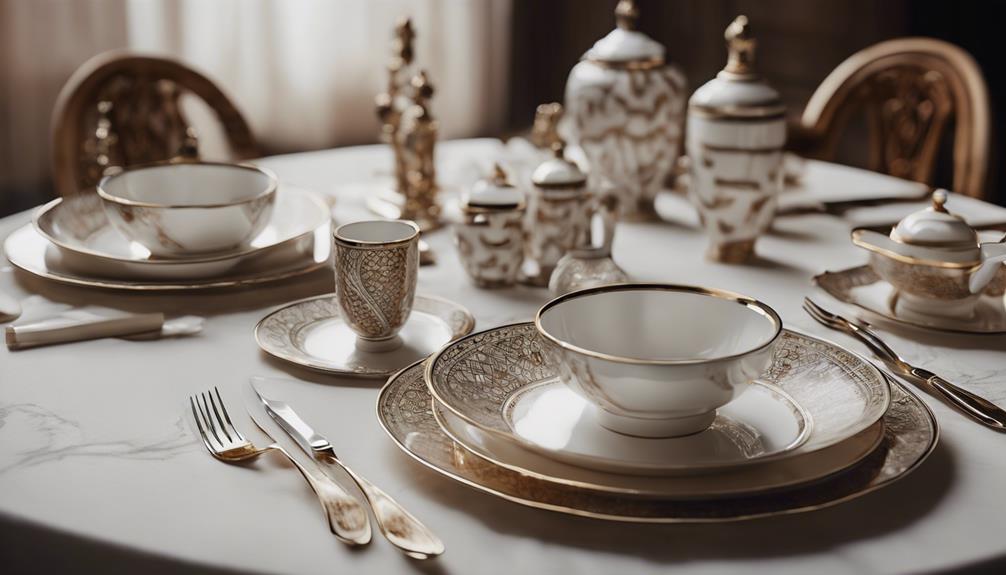Tableware encompasses plates, utensils, and glassware for dining purposes. Crockery, on the other hand, refers to ceramic dishes such as china and porcelain specifically for serving and eating meals. The materials used differ; tableware includes options like glass and metal, while crockery typically features china or porcelain, commonly found in formal dining settings. Tableware offers a wider range of styles from modern to intricate designs, while crockery focuses on enriching dining experiences with unique patterns and textures. Crockery emphasizes durability and heat resistance, requiring delicate handling, whereas tableware caters to various dining requirements. If interested in learning more about the differences between the two, there is further exploration to be done on these essential items.
Key Takeaways
- Tableware includes dishes, utensils, and serving dishes, while crockery specifically refers to ceramic plates, bowls, and cups.
- Materials for tableware can range from ceramic, glass, wood, metal, to acrylic, while crockery is primarily made of china, porcelain, earthenware, or stoneware.
- Styles of tableware vary from modern to ornate designs, while crockery focuses on patterns, colors, and textures for dining experiences.
- Tableware offers a broader range of material options compared to crockery, catering to different cultural traditions and dining needs.
- Crockery is known for its durability and heat resistance, requiring careful maintenance, while tableware can be more delicate and versatile in material choices.
Definition of Tableware and Crockery
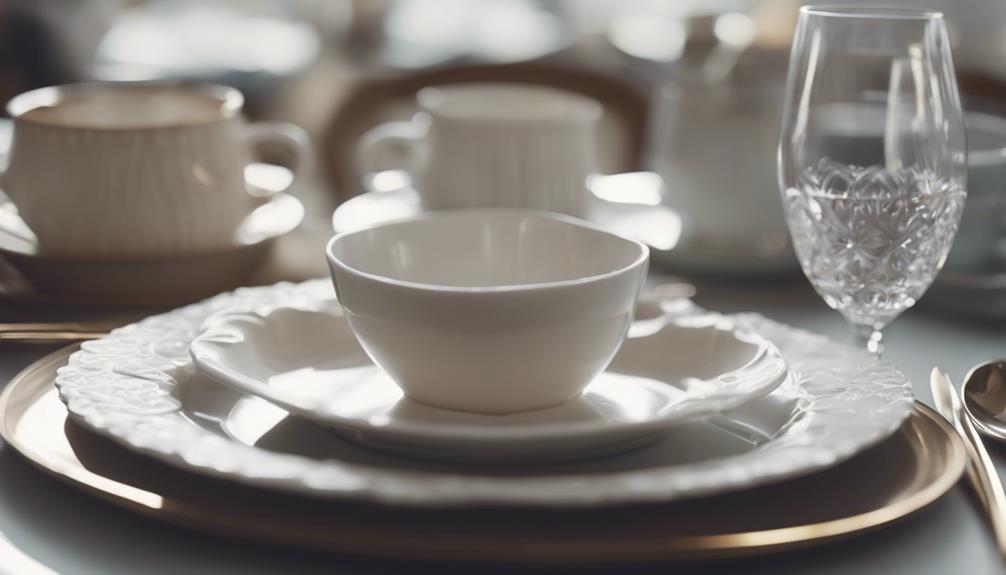
When distinguishing between tableware and crockery, it's essential to understand the specific definitions of each term. Tableware encompasses all items needed for setting a table, including dishes, utensils, plates, and serving dishes. On the other hand, crockery refers specifically to dishes made of ceramic materials like china, porcelain, earthenware, or stoneware. While tableware includes a broader range of items like cutlery and glassware, crockery hones in on plates, bowls, and cups used for serving and eating food.
Tableware offers a more extensive selection for table settings, catering to various dining needs with items beyond just crockery. In contrast, crockery focuses on the ceramic components of tableware, emphasizing the serving and presentation of food. Understanding the distinction between tableware and crockery is important for selecting the right items for different occasions, ensuring a well-equipped dining experience tailored to your specific needs.
Materials Used in Tableware Vs. Crockery
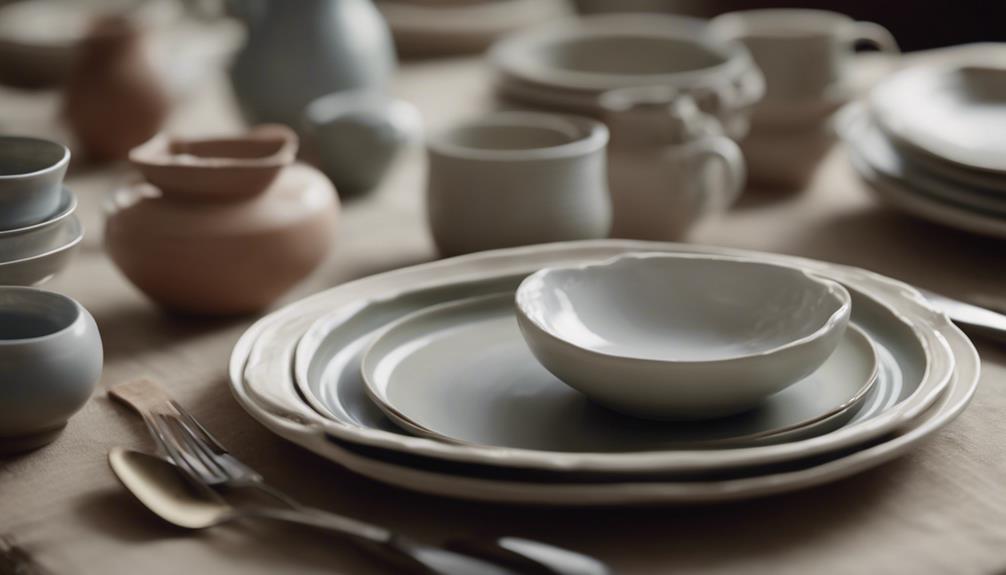
To further distinguish between tableware and crockery, it's crucial to take into account the distinct materials utilized in each category. Tableware encompasses a variety of materials such as ceramic, glass, wood, metal, and acrylic, offering a wide selection to suit different dining needs. For everyday use, materials like tempered glass and melamine are practical choices.
On the other hand, crockery is typically crafted from materials like china, pottery, earthenware, stoneware, and porcelain, emphasizing durability and aesthetic appeal. China and porcelain are often associated with formal dining occasions due to their elegance and sophistication. While ceramic materials are commonly used in both tableware and crockery, the specific types and designs vary based on cultural traditions and intended use.
Therefore, the distinction between tableware and crockery lies not only in their purposes but also in the materials used, with tableware offering a broader range of options compared to the specific materials traditionally associated with crockery.
Styles and Designs in Tableware and Crockery
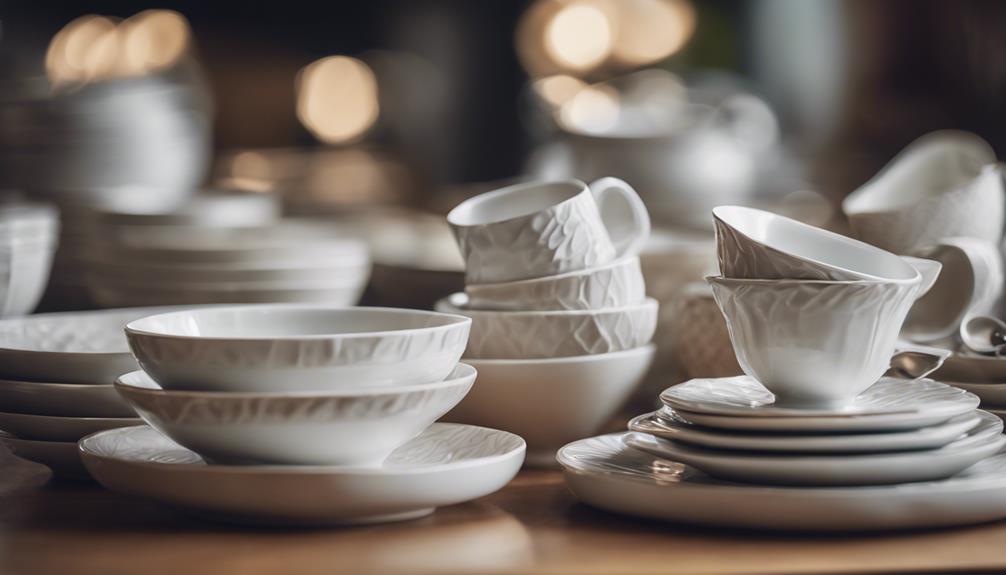
When it comes to styles and designs in tableware and crockery, you'll find a wide variety to suit different tastes and occasions.
Tableware can range from sleek and modern to elaborate and ornate, catering to various aesthetic preferences.
Crockery often features patterns, colors, and textures that enhance the overall dining experience and table presentation.
Material Choices
Exploring the diverse material choices available in tableware and crockery reveals a spectrum of styles and designs to suit various dining preferences and occasions.
When it comes to plates and bowls, ceramic is a popular choice for both crockery and tableware due to its elegant appearance. Glass tableware offers a modern and sleek aesthetic, while metal provides durability and a contemporary touch. Wood gives a rustic and natural feel to table settings, perfect for a cozy atmosphere.
For a more casual option, melamine is lightweight and break-resistant, ideal for outdoor dining or informal gatherings. Each material brings its unique characteristics, adding flair to your dining experience.
Functional Aspects
In considering the functional aspects of styles and designs in tableware and crockery, one can appreciate the intricate balance between aesthetics and usability. Crockery, made of ceramic materials like stoneware or porcelain, focuses on the design and functionality of plates, bowls, and cups used for serving dishes during meals. These pieces are crafted to be both visually appealing and practical for serving purposes.
Tableware, on the other hand, encompasses a broader range of items that complete the dining experience, including serve ware and drinkware. The distinction lies in the specific use of crockery for serving dishes and its material composition. Whether it's elegantly designed plates or durable serving dishes, the functionality of tableware and crockery enhances the dining experience.
Functionality of Tableware and Crockery

To understand the functionality of tableware and crockery, it's essential to distinguish their specific roles in dining settings. Crockery, which includes plates and bowls, is primarily focused on serving and eating food, emphasizing both aesthetics and functionality. These items are designed to hold and present food during meals, enhancing the dining experience.
On the other hand, tableware encompasses a wider range of items such as dishes, utensils, and serveware. It plays a more inclusive role in setting the table, serving food, and facilitating the consumption of meals.
Crockery, typically made from materials like ceramic or porcelain, prioritizes durability and heat resistance to withstand frequent use. In contrast, tableware can be crafted from various materials like stainless steel, glass, or melamine, catering to different dining needs.
Maintenance and Durability Contrasts
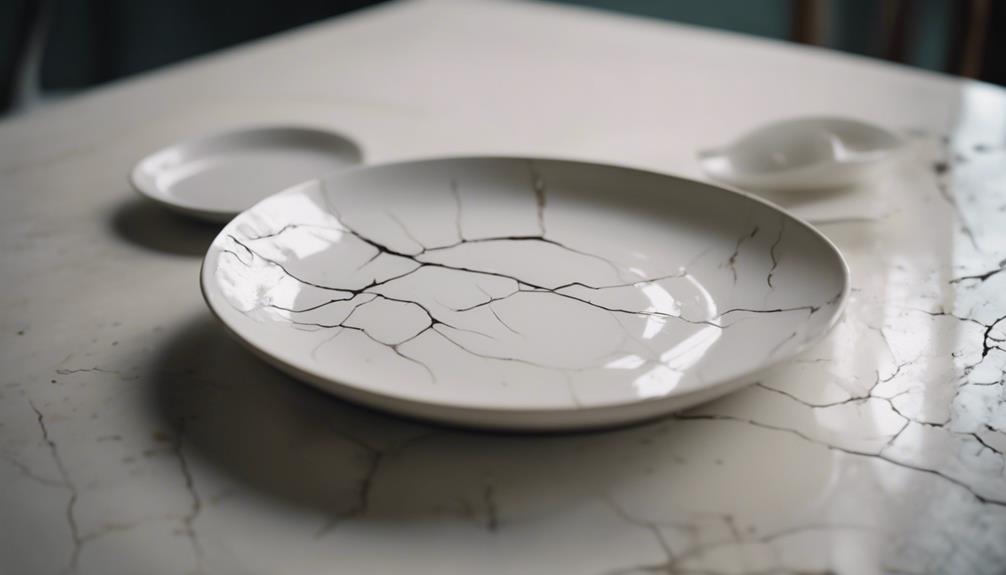
Crockery is known for its durability compared to tableware. It is often made from sturdy materials like stoneware or porcelain.
Tableware, on the other hand, requires more careful handling to prevent damage due to its delicate nature.
Understanding these maintenance differences can help you make informed choices when selecting between tableware and crockery for your dining needs.
Cleaning Differences
When caring for your tableware items, it's important to understand the distinct cleaning requirements that differentiate various materials and types within this category. Here are some key differences in cleaning practices between crockery and other forms of tableware:
- Crockery, like porcelain or stoneware, needs gentle handwashing to preserve glazes.
- Tableware includes crockery, glassware, and cutlery, each with specific cleaning needs.
- Crockery is delicate and more prone to chipping and breakage.
- Avoid abrasive cleaners or dishwashers to maintain the longevity of crockery.
- Careful handling, avoiding sudden temperature changes, and stacking properly can enhance crockery's lifespan.
Longevity Comparison
For comparing the maintenance and durability of crockery with other tableware materials, consider the long-term resilience and aesthetic retention that characterize each option. Crockery, typically made of ceramic or porcelain, is known for its durability and longevity compared to materials like glass or melamine. Its resistance to scratches, stains, and chipping contributes to its longevity, making it a preferred choice for dining settings. Proper care, such as handwashing and avoiding extreme temperature changes, can greatly extend the lifespan of crockery. While glass and melamine may offer versatility and affordability, crockery stands out for its enduring quality and ability to maintain its aesthetic appeal over time.
| Feature | Crockery |
|---|---|
| Durability | Highly durable |
| Maintenance | Requires care |
| Longevity | Long-lasting |
| Aesthetics | Maintains appeal well |
Popular Brands Offering Tableware and Crockery
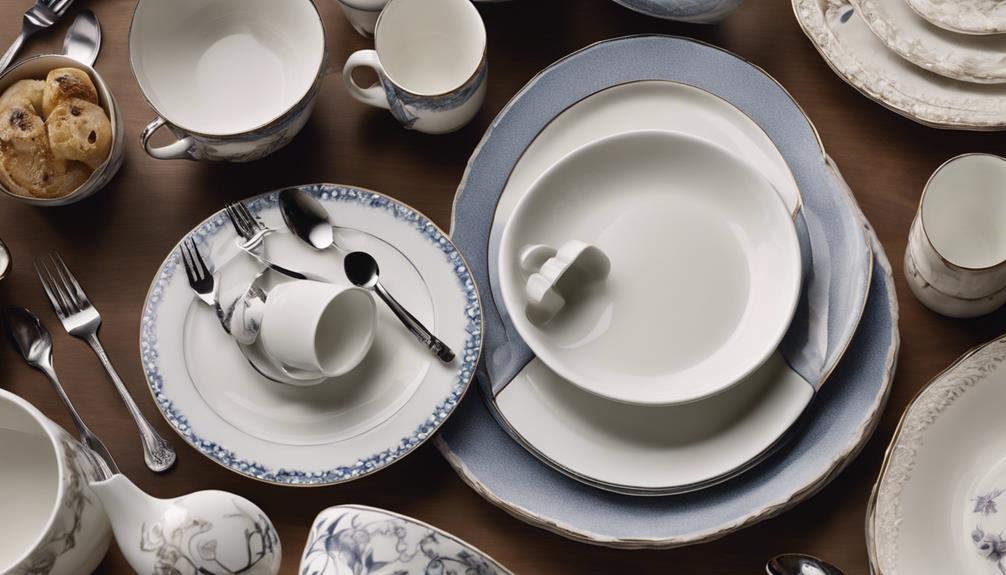
Renowned brands such as Wedgwood, Royal Doulton, Lenox, Noritake, and Villeroy & Boch offer a diverse selection of high-quality tableware and crockery known for their durability and intricate designs. These brands are trusted globally for their exceptional craftsmanship and attention to detail.
- Wedgwood: Established in 1759, Wedgwood is famous for its elegant bone china tableware and crockery, showcasing timeless designs.
- Royal Doulton: Founded in 1815, Royal Doulton is renowned for its fine porcelain and ceramic tableware collections, blending tradition with modernity.
- Lenox: Lenox offers a wide range of tableware and crockery options, catering to various styles and preferences with its premium quality products.
- Noritake: Known for its sophisticated designs, Noritake provides a diverse selection of tableware and crockery that combines beauty with functionality.
- Villeroy & Boch: Villeroy & Boch is celebrated for its innovative designs and high-quality materials, offering unique and stylish tableware options for every occasion.
Frequently Asked Questions
What Is an Example of a Crockery?
An example of crockery is a set of elegant bone china tea cups. These delicate yet durable cups are known for their fine quality, heat retention, and exquisite designs.
They elevate your tea-drinking experience with their beauty and functionality. Bone china tea cups are a classic choice for serving hot beverages in style, adding a touch of sophistication to any tea time.
Enjoy your tea in luxury with these exquisite crockery pieces.
What Are the Four Classifications of Tableware?
When it comes to tableware, there are four main classifications:
Serve ware includes items like serving platters and teapots for food presentation.
Dinnerware consists of plates and bowls in different materials.
Silverware and cutlery are your knives, forks, and spoons made from various materials.
And finally, drinkware covers all your cups and glasses for different beverages.
Each serves a specific dining purpose.
Does Spoon Come Under Crockery?
Yes, a spoon isn't categorized under crockery but falls under cutlery. Crockery typically includes items like plates, bowls, cups, and saucers used for serving and eating food.
In contrast, cutlery refers to tools like knives, forks, and spoons designed for cutting and eating. So, while crockery serves food, cutlery, including spoons, is specifically meant for eating purposes.
What Is the Difference Between Utensils and Crockery?
In the domain of dining, utensils and crockery serve distinct purposes. Utensils such as knives, forks, and spoons are tools for cutting and consuming food, while crockery like plates and bowls is used for presenting and serving meals.
The difference lies in function: crockery showcases food, while utensils aid in eating. Materials also differ, with crockery commonly made from ceramic and utensils from metals like stainless steel or silver.
Conclusion
To sum up, a noteworthy difference between tableware and crockery lies in their materials, styles, functionality, and maintenance. While tableware is often made of various materials like glass, metal, or plastic, crockery is typically made of ceramic or porcelain.
Tableware tends to offer a wider range of designs and styles, catering to different preferences. On the other hand, crockery is known for its durability and longevity.
It's worth noting that statistics show that the global tableware market is projected to reach $40 billion by 2025, highlighting the importance and demand for these essential dining items.
